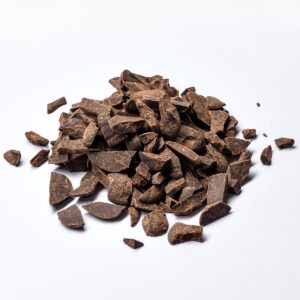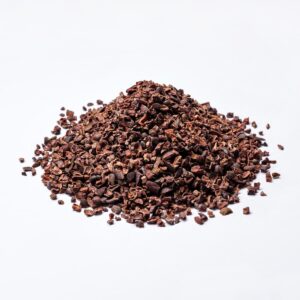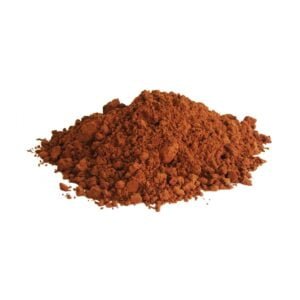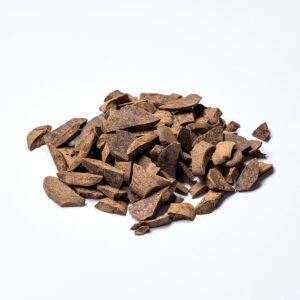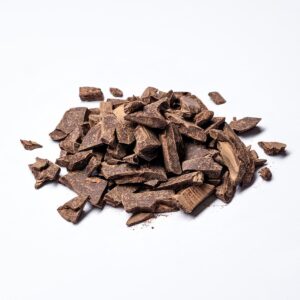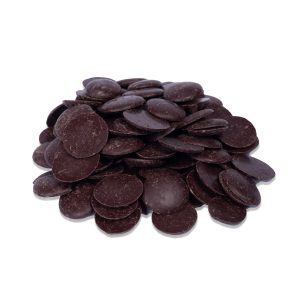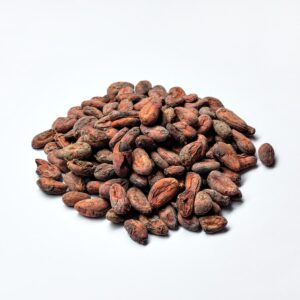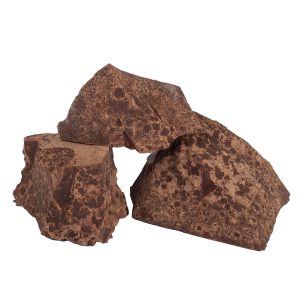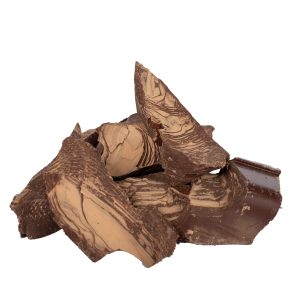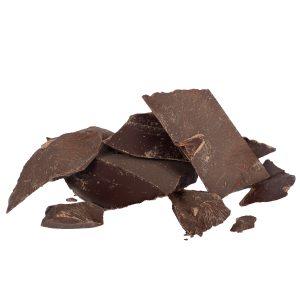Drinking chocolate, or hot chocolate, is a well-known drink that has been accompanying us in cafés and restaurants for years, either as an accompaniment to a meal or as a treat on its own. Liquid drinkable chocolate has also made its way into our homes: it can be made with special powder, chocolate in pastilles and bars or from scratch using pure cacao. Since recently, you can also get this delicacy in our online shop. Where did hot chocolate come from, what types are there and how to prepare it correctly?
The roots of hot chocolate can be traced back to drinks made by the Maya and Aztecs of the Gulf of Mexico, which were, however, cool and quite far from what we enjoy today - especially in winter - in cafés. The Aztecs basically prepared two types of liquid cacao: an alcoholic wine-like drink made from the paste surrounding the cacao beans, and a rather bitter, cool drink created from the beans themselves [1]. For hundreds of years, drinking chocolate was seen as a sacred decoction that added vigour, worthy of a great warrior who, using cacao, gains even greater strength [2]. It was only after the conquistadors brought cacao to Europe in the 16th century that the Aztec drink, rich in chilli and cinnamon flavours, changed its function somewhat [1]. However, it did not immediately become a sweet treat for cold evenings - in Europe too, liquid food chocolate was regarded as a drink worthy of a strong man: a soldier or a gentleman [2]. After all, it was not without reason that the cocoa tree was given the Greek name Theobroma cacao - "Food for the gods"!
But how did the history of hot chocolate on the Old Continent actually begin? At first, the process of making the drink resembled a recipe practised in Mesoamerica. The cacao beans were fermented, dried and roasted, and then the shells were separated from them and crushed to form a cacao paste. Such a paste, mixed with water, was the first cocoa beverage to be known both overseas and in Europe. However, in 1828, the Dutch chemist Coenraad Joahennes van Houten invented a way to separate the fats from the cocoa beans, thereby obtaining the first ever cocoa powder. This powder made it possible to prepare a beverage that is popularly called simply 'cocoa' in Poland today. Adding the fat back to the powder, on the other hand, led to the base of hot chocolate - and this is where the actual history of the drink that we still consume today begins [2].
The custom of drinking chocolate quickly spread throughout Europe and came to be regarded as a symbol of prestige and elitism - although, interestingly, many Europeans regarded hot chocolate as a typically Catholic drink. Protestants, on the other hand, preferred to stick with coffee [2]. Interestingly, some sources state that the recipe for drinkable drinking chocolate originated at the court of Philip II in Spain, where its health benefits were noted, and vanilla, cinnamon, sugar and nuts began to be added [1]. A big step forward in the development of hot chocolate was also the replacement of water with milk, which is often still done today [3]. As you can see, the history of drinking chocolate is rich and goes back to ancient times - and it is worth adding that for a long time it was an exclusive drink in gentlemen's clubs in the UK [2]! From there, it's not far to the present day, where hot chocolate is a popular, fortifying drink. However, there are still chocolatiers in Europe where you can enjoy it in a slightly more exclusive way!
What places to recommend to a true, dedicated hot chocolate fan? The first would undoubtedly be the de San Ginés chocolate shop in Madrid, opened in 1894 (!), which offers the famous Spanish churros with chocolate. The drinking chocolate prepared there is said to be second to none, and lovers of the drink can also purchase a wide variety of chocolate-making accessories at the chocolatier, as well as their own chocolate to prepare at home [4]!
Another place no hot chocolate fan should miss is the 'Old Chocolate House' in Bruges. Here, instead of the fantastic combination of chocolate and churros, you'll come across a whole range of options that you can even enjoy! Hot chocolate with milk, dark chocolate, milk chocolate and white chocolate, topped with waffles or rum or amaretto, served with marshmallows or whipped cream… [5] the options are endless! If you are a fan of drinking chocolate in different editions, be sure to check out this chocolatier!
The Angelina chocolate shop, which dates back to 1903, would also be remiss not to mention here. This place is still an icon of Paris today, and the drinking chocolate created here is made from a secret recipe! All that is known about the recipe is that it recommends making the drink from cocoa beans that grow in Nigeria, Ghana and the Ivory Coast - these trees are grown specifically for Angelina! The combination of beans from the three countries is said to give the hot chocolate here a strong, rich flavour. Served with whipped cream, it is likely to be a memorable treat [5].
When drinking hot chocolate at these places, it is worth remembering the famous people who may have visited there over the past two centuries. Of the most famous ones, for example, we have Amelia Earhart, the famous pilot who is said to have enjoyed a cup of hot chocolate before her flights across the Pacific [6]. And speaking of oceans, many years earlier on the other side of the Atlantic, Thomas Jefferson, one of the founding fathers of the United States, was also reportedly a big fan of drinking chocolate [7]!
We currently offer several types of drinking chocolate in our shop: a slightly more dry chocolate with a high cacao content and natural rum flavouring, milk chocolate and white chocolate. This range will, of course, be expanded in the future!
As for dark chocolate, it functions as a drink analogous to its bar version. Thanks to the highest content of pure cacao, dark drinking chocolate is not very sweet, aromatic and wholesome. An absolute must-have for rigorous fans of real cacao!
A more classic variant is, of course, milk drinking chocolate, still rich in cacao and suitable not only for drinking, but also for munching or making the truest chocolate coating. Hot milk chocolate has a lighter taste than its cousin, dark chocolate - so it's more of a dessert type, and its lower fat content means we can consume it as a side dish or between meals without risking overeating.
Finally, we also have a drink to satisfy fans of white chocolate bars. While white drinking chocolate resembles its milk-based big brother in content, it differs in taste and aroma. Creamy and light, it is sure to meet the tastes of fans of alternative treats containing cacao. Just like milk chocolate, it can also be crunched or used to make confectionery toppings.
It is also worth mentioning a type of drinking chocolate that we do not have in our shop at the moment (although we are working on it!). We are talking about pink hot chocolate, an invention that is only 5 years old! Prepared from the beans of the Ruby cocoa tree, which grows in the Ivory Coast, pink chocolate not only has a different colour, but also a different taste and aroma [8] - it is slightly fruity and slightly more acidic than traditional chocolate [9]. Work on the recipe for pink chocolate took a whole 10 years and it is the first new type of bar since the discovery of the method for making white chocolate! Perhaps we will soon find out for ourselves what this innovative wonder tastes like.
Finally, the best part - which is the recipes! Once you have bought your hot chocolate, it's time to make it in your own four walls - whether for yourself, guests or your partner and children. How do you go about it? Should you use water or milk? How long do you need to heat the drink? We explain!
Put about 20g of chocolate (the more, the more intense the flavour!) into a mug and pour over 200ml of warmed but not boiled milk. Stir and you're ready to go!
To start with, whisk 1 teaspoon of cornflour with 1 tablespoon of milk until it is the consistency of a paste. Add 20g of chocolate, 1 teaspoon of cinnamon and the resulting paste to 250ml of hot (but not boiling!) milk. Heat until the drink doesn't thicken - and you're done! [3].
A slightly less calorific option for hot chocolate fans is chocolate made with water - it is slightly less thick and creamy and more dry [10]. To prepare such chocolate, first heat 250ml of water and dissolve 20g of chocolate in it. The aroma and flavour of the drink should be complemented with cinnamon, vanilla or nuts!
Showing all 18 results
